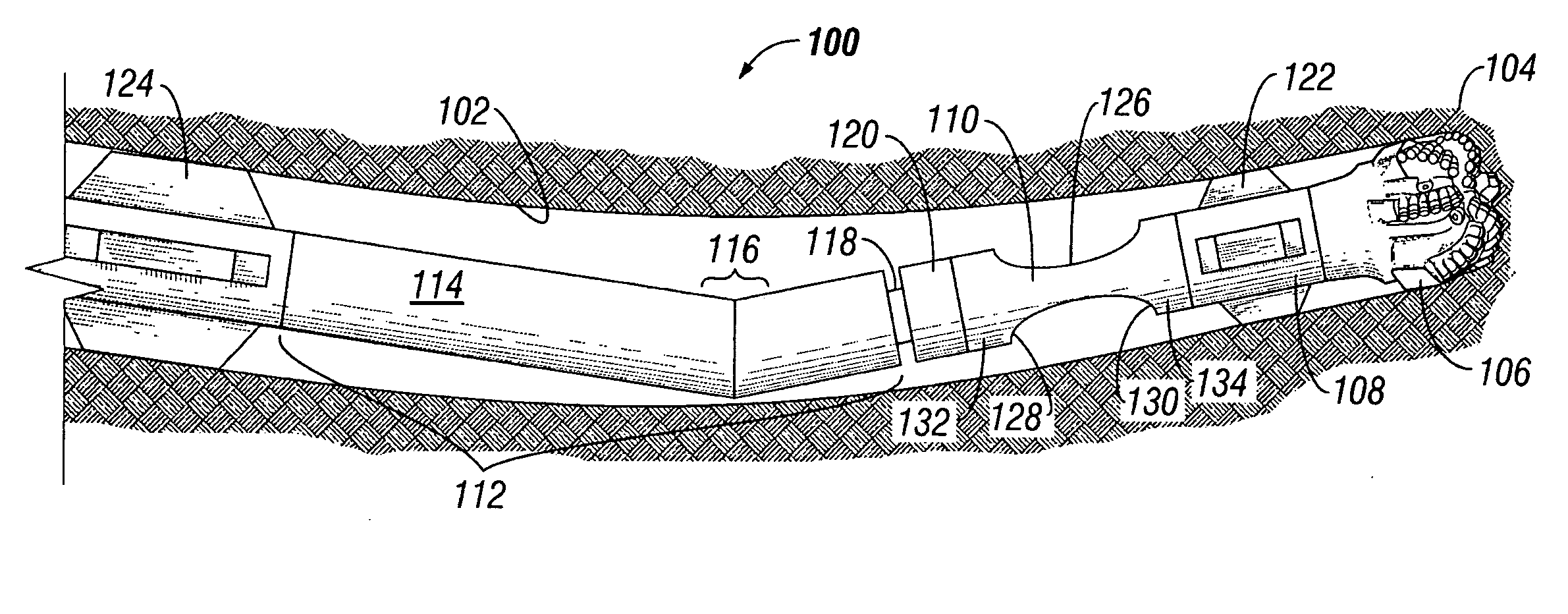Flexible directional drilling apparatus and method
a directional drilling and flexible technology, applied in directional drilling, drilling pipes, cutting machines, etc., can solve the problems of borehole deviation, high lateral load on the bit, and borehole not maintaining a vertical trajectory along its entire depth,
- Summary
- Abstract
- Description
- Claims
- Application Information
AI Technical Summary
Benefits of technology
Problems solved by technology
Method used
Image
Examples
first embodiment
[0037] Referring now to FIG. 1, a bottom hole assembly 100 in accordance with the present invention is schematically shown drilling a borehole 102 in a subterranean formation 104. Bottom hole assembly 100 includes a drill bit 106, a stabilizer assembly 108, a flex member 110, and a drilling assembly 112. Drilling assembly 112, preferably includes a drive mechanism 114 and a directional mechanism 116. In the embodiment shown in FIG. 1, drive mechanism 114 includes a positive displacement mud motor and directional mechanism 116 includes a bent housing assembly integral to the mud motor. As such, an output shaft 118 of positive displacement mud motor 114 extends below bent housing 116 and provides a rotary threaded connection 120 to lower components of BHA 100. Output shaft 118 is powered by the positive displacement mud motor, and therefore rotates relative to the external housing of drive mechanism 114. While drill bit 106 is shown schematically as a polycrystalline diamond compact d...
second embodiment
[0041] Referring now to FIG. 2, a bottom hole assembly 200 in accordance with the present invention is schematically shown drilling a borehole 102 in a subterranean formation 104. Bottom hole assembly 200 includes a drill bit 206, a stabilizer assembly 208, a flex member 210, and a drilling assembly 212. Drilling assembly 212, preferably includes a drive mechanism 214 and a directional mechanism 216. In the embodiment shown in FIG. 2, drive mechanism 214 is a drillstring rotated from the surface and directional mechanism 216 includes an articulated joint of a point-the-bit rotary steerable system. The output housing or shaft of the directional mechanism rotates at the same speed as that of the drive mechanism. As such, flex member 210, similarly to flex member 110 of FIG. 1, includes a reduced outer diameter portion 226 that reduces the magnitude of side loads and stresses experienced by articulated RSS joint 216. In bottom hole assembly 200, drive mechanism 214 may be a turbine or ...
third embodiment
[0042] Referring now to FIG. 3, a bottom hole assembly 300 in accordance with the present invention is schematically shown drilling a borehole 102 in a subterranean formation 104. Bottom hole assembly 300 includes a drill bit 306, a stabilizer assembly 308, a flex member 310, and a drilling assembly 312. Drilling assembly 312, preferably includes a drive mechanism 314 and a directional mechanism 316. In the embodiment shown in FIG. 3, drive mechanism 314 includes a positive displacement mud motor and directional mechanism 316 includes a bent housing. Bottom hole assembly 300 of FIG. 3 differs from bottom hole assembly 100 of FIG. 1 in that flex member 310 is integrated into what would have been an output shaft (e.g. 118 of FIG. 1) of positive displacement mud motor 314. While flex member 110 of FIG. 1 is capable of being retrofitted to any drilling assembly, flex member 310 is specifically designed, tailored, and optimized for a particular drilling assembly 312. Therefore, drilling ...
PUM
 Login to View More
Login to View More Abstract
Description
Claims
Application Information
 Login to View More
Login to View More - R&D
- Intellectual Property
- Life Sciences
- Materials
- Tech Scout
- Unparalleled Data Quality
- Higher Quality Content
- 60% Fewer Hallucinations
Browse by: Latest US Patents, China's latest patents, Technical Efficacy Thesaurus, Application Domain, Technology Topic, Popular Technical Reports.
© 2025 PatSnap. All rights reserved.Legal|Privacy policy|Modern Slavery Act Transparency Statement|Sitemap|About US| Contact US: help@patsnap.com



